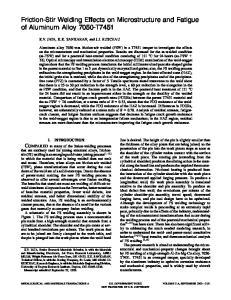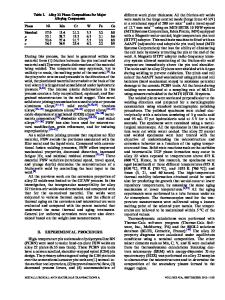Effects of Friction Stir Processing on the Phase Transformation and Microstructure of TiO 2 -Compounded Ti-6Al-4V Alloy
- PDF / 3,766,548 Bytes
- 5 Pages / 593.972 x 792 pts Page_size
- 21 Downloads / 316 Views
se of high strength, low density, and high strength-to-weight ratio, titanium alloys have been widely used in aerospace, chemical, nuclear industries, and load-bearing implants.[1,2] Among all of titanium alloys, Ti-6Al-4V alloy is the most frequently and successfully used alloy in various industries due to its favorable properties.[3] However, as a popular implant material, Ti-6Al-4V alloy presents poor surface properties such as low abrasive resistance in harsh
ZIHAO DING and CHENGJIAN ZHANG, Undergraduate Students, LECHUN XIE, Researcher, and LIQIANG WANG and WEIJIE LU, Professors, are with the State Key Laboratory of Metal Matrix Composites, School of Materials Science and Engineering, Shanghai Jiao Tong University, No. 800 Dongchuan Road, Shanghai 200240, P.R. China, and also with the Collaborative Innovation Center for Advanced Ship and Deep-Sea Exploration, Shanghai 200240, P.R. China. Contact e-mail: [email protected] LAI-CHANG ZHANG, Professor, is with the School of Engineering, Edith Cowan University, 270 Joondalup Drive, Joondalup, Perth, WA, 6027, Australia. Zihao Ding and Chengjian Zhang have contributed equally to this work. Manuscript submitted June 12, 2016. METALLURGICAL AND MATERIALS TRANSACTIONS A
environments which limits its performance and service life.[4] Besides, it has been reported that tiny titanium particles are found in soft tissues adjacent to implants accompanied by inflammation because of the abrasion and corrosion in human bodies.[5,6] Therefore, different measures were taken to improve the surface properties of Ti-6Al-4V alloy, including decreasing grain size and improving hardness of surface, in order to further satisfy the requirements of implants. Friction stir processing is attempted to realize microstructural modification and facilitates to introduce second-phase particles into matrix material to optimize the surface composition through large plastic deformation and metal flow.[7–9] In recent years, researchers have successfully used friction stir processing to obtain enhanced composite layers on the surface of different matrices. Zarghani et al. used 6082 aluminum-based alloys as the matrix and Al2O3 as the enhancing particles to build a composite layer. They found that increasing in number of friction stir processing pass could enhance the uniform distribution of Al2O3 particles.[10] Dixit et al. succeeded in building aluminum-based alloys reinforced by NiTi particles.[11] Adem et al. found that SiC particles could improve the surface properties when they are combined with matrix metals using friction stir processing.[12] Based on previous researches, we also try to add second-phase particles when using friction stir processing on Ti-6Al-4V. As such, TiO2 particles are chosen as the reinforcing particles in this work because of the following two main reasons. First, TiO2 particles could improve the surface properties since friction stir processing induces grain refinement to nanoscale in the composite layer.[13] Second, toxicity of TiO2 particles at concentration below 1 mg
Data Loading...











